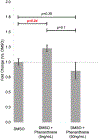Placental transcriptomic signatures of prenatal exposure to Hydroxy-Polycyclic aromatic hydrocarbons
- PMID: 36689866
- PMCID: PMC10211546
- DOI: 10.1016/j.envint.2023.107763
Placental transcriptomic signatures of prenatal exposure to Hydroxy-Polycyclic aromatic hydrocarbons
Abstract
Background: Polycyclic aromatic hydrocarbons (PAHs) are ubiquitous pollutants originating from petrogenic and pyrogenic sources. PAH compounds can cross the placenta, and prenatal PAH exposure is linked to adverse infant and childhood health outcomes.
Objective: In this first human transcriptomic assessment of PAHs in the placenta, we examined associations between prenatal PAH exposure and placental gene expression to gain insight into mechanisms by which PAHs may disrupt placental function.
Methods: The ECHO PATHWAYS Consortium quantified prenatal PAH exposure and the placental transcriptome from 629 pregnant participants enrolled in the CANDLE study. Concentrations of 12 monohydroxy-PAH (OH-PAH) metabolites were measured in mid-pregnancy urine using high performance liquid chromatography tandem mass spectrometry. Placental transcriptomic data were obtained using paired-end RNA sequencing. Linear models were fitted to estimate covariate-adjusted associations between maternal urinary OH-PAHs and placental gene expression. We performed sex-stratified analyses to evaluate whether associations varied by fetal sex. Selected PAH/gene expression analyses were validated by treating HTR-8/SVneo cells with phenanthrene, and quantifying expression via qPCR.
Results: Urinary concentrations of 6 OH-PAHs were associated with placental expression of 8 genes. Three biological pathways were associated with 4 OH-PAHs. Placental expression of SGF29 and TRIP13 as well as the vitamin digestion and absorption pathway were positively associated with multiple metabolites. HTR-8/SVneo cells treated with phenanthrene also exhibited 23 % increased TRIP13 expression compared to vehicle controls (p = 0.04). Fetal sex may modify the relationship between prenatal OH-PAHs and placental gene expression, as more associations were identified in females than males (45 vs 28 associations).
Discussion: Our study highlights novel genes whose placental expression may be disrupted by OH-PAHs. Increased expression of DNA damage repair gene TRIP13 may represent a response to double-stranded DNA breaks. Increased expression of genes involved in vitamin digestion and metabolism may reflect dietary exposures or represent a compensatory mechanism to combat damage related to OH-PAH toxicity. Further work is needed to study the role of these genes in placental function and their links to perinatal outcomes and lifelong health.
Keywords: Developmental origins of health and disease; Placenta; Polycyclic aromatic hydrocarbons; TRIP13; Transcriptomics.
Copyright © 2023 The Author(s). Published by Elsevier Ltd.. All rights reserved.
Conflict of interest statement
Declaration of Competing Interest The authors declare that they have no known competing financial interests or personal relationships that could have appeared to influence the work reported in this paper.
Figures




References
-
- Alghamdi MA, Alam MS, Stark C, Mohammed N, Harrison RM, Shamy M, Khoder MI, Shabbaj II, Göen T, 2015. Urinary Metabolites of Polycyclic Aromatic Hydrocarbons in Saudi Arabian Schoolchildren in Relation to Sources of Exposure. Environmental Research 140 (July), 495–501. 10.1016/j.envres.2015.04.023. - DOI - PubMed
Publication types
MeSH terms
Substances
Grants and funding
LinkOut - more resources
Full Text Sources
Molecular Biology Databases

